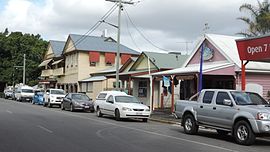Miriam Vale, Queensland
|
Miriam Vale Queensland |
|||||||||||||
|---|---|---|---|---|---|---|---|---|---|---|---|---|---|

Blomfield Street (main street looking south-east), 2016
|
|||||||||||||
| Coordinates | 24°19′0″S 151°33′0″E / 24.31667°S 151.55000°ECoordinates: 24°19′0″S 151°33′0″E / 24.31667°S 151.55000°E | ||||||||||||
| Population | 422 (2011 census) | ||||||||||||
| Postcode(s) | 4677 | ||||||||||||
| Location |
|
||||||||||||
| LGA(s) | Gladstone Region | ||||||||||||
| State electorate(s) | Burnett | ||||||||||||
| Federal Division(s) | Flynn | ||||||||||||
|
|||||||||||||
Miriam Vale is a town and locality in the Gladstone Region, Queensland, Australia. In the 2011 census, Miriam Vale had a population of 422 people.
The town is situated on the Bruce Highway, 464 kilometres (288 mi) north of Brisbane, the state capital, and 170 kilometres (110 mi) south of Rockhampton.
Miriam Vale is renowned as a traditional cattle growing area, and also supports timber, beef and dairy cattle. Tourism is an emerging industry within the shire and the town is a gateway to the tourist resorts of Agnes Water and the Town of 1770.
In the 1970s signs at the entry to town proudly proclaimed "Welcome to Miriam Vale - Cattle, Tobacco, Timber and Dairy". The tobacco industry faded in the late 1970s followed by the dairy industry in the 1990s.
Miriam Vale Post Office opened on 1 April 1877.
Miriam Vale State School opened on 14 July 1897.
The timber industry has roots in the late 19th century, with early timber cutters working along the Bobby Range cutting hoop pine. In these early days hoop pine was cut and two timer chutes allowed logs to be shot to the foot of the range where bullock wagons were waiting. Evidence of these old chutes can still be found at the back of Boreelum on the sides of the range. The southern chute was on tram rails and consisted of two carriages. As the log was lowered down the mountain the other empty carriage was drawn to the top. This was achieved by a small overtaking siding in the middle. The other chute to the west was smaller and built out of logs. The timber was in most cases ferried to rail at Lowmead.
There were also many timber mills in the district but many of these closed in the late part of the century. Perhaps the closest mill to town was located on the flat at House Creek.
The dairy industry has the most claim to fame with a massive fig tree near the railway station being the drop off point of "cream cans" full of milk. This depot (being no more than a wooden stage) was the district dairy focal point. Locals would deliver the fresh milk to the depot where it was then loaded onto Claude's Truck for the trip to the Port Curtis Dairy (PCD). Fresh milk wasn't always the delivery and in the 1950s cream was separated on farms and delivered to town. Cream in those days was sold on "degrees of Rancid" (fresh, ripe, stale) as there was no refrigeration. The cream even then was going to the PCD in Gladstone.
...
Wikipedia

